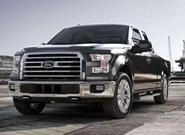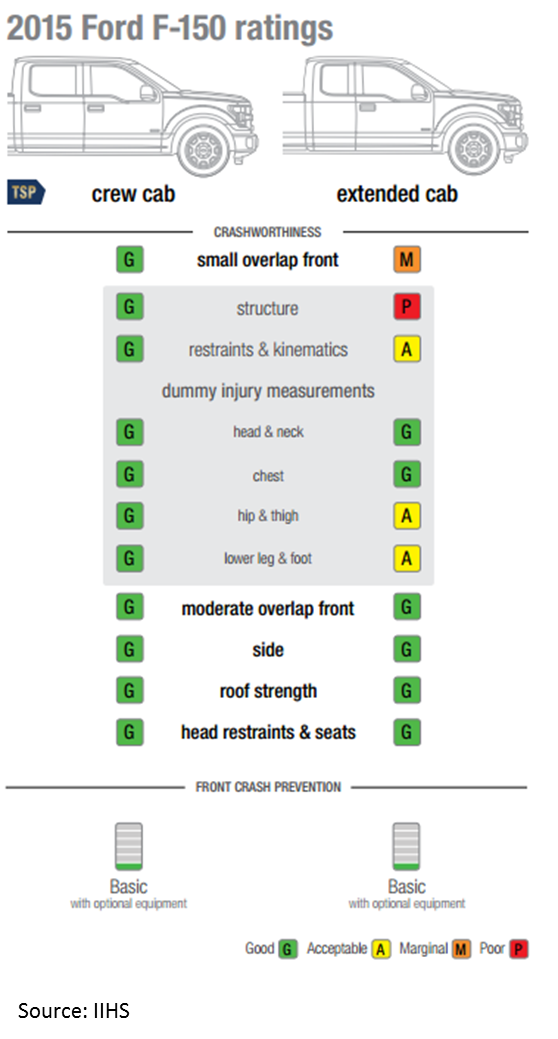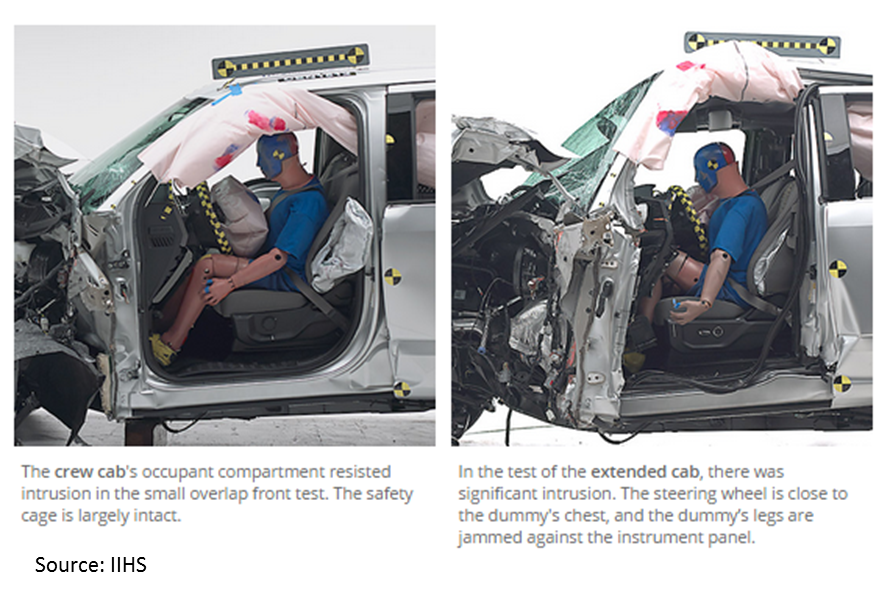Steel Markets

IIHS Report Looks at Safety and Repair Costs of F-150
Written by Sandy Williams
August 2, 2015
The all-aluminum Ford F-150 is going to cost you more to repair—so says the Insurance Institute for Highway Safety (IIHS).
IIHS put the F-150 crew cab and the F-150 extended cab through a series of five crash tests. The crew cab model passed all of them with flying colors giving it the Top Safety Pick award. The extended cab, however, needs some improvements according to the IIHS crash results.
In a test that replicates a front driver side collision at 40 miles per hour, a crash of the crew cab version caused little to no injury to the Hybrid III dummy positioned at the steering wheel. In the collision of the extended cab F-150, vehicle structure “seriously compromised the driver’s survival space” by protruding into the cab by 10-13 inches and placing the steering column perilously close to the driver’s chest. The dummy’s head “barely contacted the front airbag before sliding off to the left and hitting the instrument panel” reported IIHS.”
IIHS then looked at repair costs for the two vehicle models. Comparing a 2015 aluminum F-150 and the 2014 steel-bodied F-150, IIHS replicated two low speed crashes. In the first test, the steel vehicle struck the front left corner of the aluminum pickup at 10 mph with a 15 percent overlap. In the second test the front left corner of the aluminum vehicle struck the rear corner of the steel one at the same speed and overlap.
In both tests the aluminum F-150 had more extensive damage than its steel counterpart. Both trucks were repaired at a Ford aluminum repair certified dealership. The front test damage cost $4,147 for the aluminum model and $3,759 for the steel model. The rear collision test had similar repair results, $4,738 for the aluminum model and $3,276 for the steel pickup. Repairs were 26 percent higher for the aluminum model.
 Part of the cost to repair the front damage to the aluminum F-150 was due to extra time required that increased labor costs. In the aluminum model, mechanics had to assemble wiring harnesses and splash guards before a new front fender could be attached. The extra time added 22 percent to labor costs when compared to the steel model.
Part of the cost to repair the front damage to the aluminum F-150 was due to extra time required that increased labor costs. In the aluminum model, mechanics had to assemble wiring harnesses and splash guards before a new front fender could be attached. The extra time added 22 percent to labor costs when compared to the steel model.
In the rear end crash, both vehicles had damage to the truck bed. The aluminum pickup needed a replacement part while the steel one could be repaired. Both vehicles needed new tail lamps, bumpers and exhaust pipes. Replacement part costs were 42 percent higher for the 2015 F-150.
The models were chosen to be reviewed because of consumer concern over the use of aluminum.
“The Institute picked the F-150 to test first because it is not only the best-selling vehicle in the U.S. but also the first mass-market vehicle with an all-aluminum body,” said the IIHS report.
When requirements to improve safety in small overlap crashes were passed, the extended cab F-150 was still in development, said a spokesperson for Ford, adding that changes will be included in the 2016 models for the supercab and regular cap pickups.
Consumer costs are in the limelight when it comes to repairs for aluminum vehicles, but body shops also incur additional costs which may be passed on to consumers. Repair methods are different for steel and aluminum and require additional training for mechanics and welders who perform service on the F-150. Due to safety requirements, there can be no cross contamination of aluminum and steel dust during repairs. Body shops must have a separate room or enclosed area to perform aluminum repairs, equipped with appropriate dust extraction methods. Separate tools are required to avoid cross contamination that could lead to corrosion.

Sandy Williams
Read more from Sandy WilliamsLatest in Steel Markets

CRU: Sheet import demand softens as domestic price gains have slowed
US domestic sheet price gains have begun to slow as previously pulled-forward demand has led to a decline in orders.

CMC looks beyond Arizona micro-mill woes to long-term viability of construction mart
Despite the economic and geopolitical upheaval of the last five years, CMC President and CEO Peter Matt points out that the construction market has been an essential element of the way forward.

US importers face stricter rules under revamped S232 tariffs
“CBP expects full compliance from the trade community for accurate reporting and payment of the additional duties. CBP will take enforcement action on non-compliance," the agency said in a March 7 bulletin.

Steel exports rebound in January
US steel exports recovered to a five-month high in January after having fallen to a two-year low in December. This growth follows four consecutive months of declining exports.

Construction spending drops marginally in January
Construction spending edged down slightly in January, slipping for the first time in four months. The US Census Bureau estimated spending at a seasonally adjusted annual rate of $2,196 billion in January, down 0.2% from December’s downward revised rate. The January figure is 3.3% higher than a year ago. January’s result, despite the slight erosion, […]

